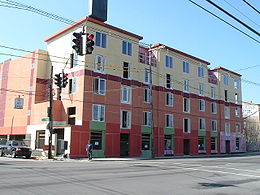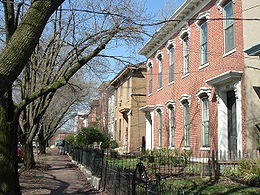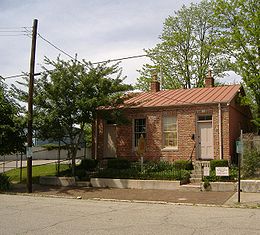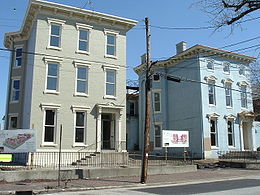
Butchertown
Encyclopedia

Downtown Louisville
Downtown Louisville is the largest central business district in the Commonwealth of Kentucky and the urban hub of the Louisville, Kentucky Metropolitan Area. Its boundaries are the Ohio River to the north, Hancock Street to the east, York and Jacob Streets to the south, and 9th Street to the west...
Louisville, Kentucky
Louisville, Kentucky
Louisville is the largest city in the U.S. state of Kentucky, and the county seat of Jefferson County. Since 2003, the city's borders have been coterminous with those of the county because of a city-county merger. The city's population at the 2010 census was 741,096...
, USA. The first homes in the area were laid out in the 1820s along the newly completed Louisville to Lexington
Lexington, Kentucky
Lexington is the second-largest city in Kentucky and the 63rd largest in the US. Known as the "Thoroughbred City" and the "Horse Capital of the World", it is located in the heart of Kentucky's Bluegrass region...
turnpike, referred to in that stretch as Story Avenue.
History
Two of the first landowners in the area, Whig PartyWhig Party (United States)
The Whig Party was a political party of the United States during the era of Jacksonian democracy. Considered integral to the Second Party System and operating from the early 1830s to the mid-1850s, the party was formed in opposition to the policies of President Andrew Jackson and his Democratic...
loyalist George Buchanan and Isaac Stewart, had the new community's streets named after major Whig Party members, such as John Quincy Adams
John Quincy Adams
John Quincy Adams was the sixth President of the United States . He served as an American diplomat, Senator, and Congressional representative. He was a member of the Federalist, Democratic-Republican, National Republican, and later Anti-Masonic and Whig parties. Adams was the son of former...
, Daniel Webster
Daniel Webster
Daniel Webster was a leading American statesman and senator from Massachusetts during the period leading up to the Civil War. He first rose to regional prominence through his defense of New England shipping interests...
and Henry Clay
Henry Clay
Henry Clay, Sr. , was a lawyer, politician and skilled orator who represented Kentucky separately in both the Senate and in the House of Representatives...
. In the 1850s Beargrass Creek was rerouted away from what is now downtown Louisville and through the area, making it an ideal area for butcher
Butcher
A butcher is a person who may slaughter animals, dress their flesh, sell their meat or any combination of these three tasks. They may prepare standard cuts of meat, poultry, fish and shellfish for sale in retail or wholesale food establishments...
s and stockyards
Feedlot
A feedlot or feedyard is a type of animal feeding operation which is used in factory farming for finishing livestock, notably beef cattle, but also swine, horses, sheep, turkeys, chickens or ducks, prior to slaughter. Large beef feedlots are called Concentrated Animal Feeding Operations . They...
because the animal remains could be dumped in the creek and such businesses were banned in the downtown area for sanitation reasons. The population swelled as waves of German
Germany
Germany , officially the Federal Republic of Germany , is a federal parliamentary republic in Europe. The country consists of 16 states while the capital and largest city is Berlin. Germany covers an area of 357,021 km2 and has a largely temperate seasonal climate...
immigrants entered the area. Bourbon Stockyards, built in 1836, was the first stockyard to locate in Butchertown — currently, parts of the original building house a bank.

Know Nothing
The Know Nothing was a movement by the nativist American political faction of the 1840s and 1850s. It was empowered by popular fears that the country was being overwhelmed by German and Irish Catholic immigrants, who were often regarded as hostile to Anglo-Saxon Protestant values and controlled by...
party, Butchertown was where the "Bloody Monday
Bloody Monday
Bloody Monday was the name given the election riots of August 6, 1855, in Louisville, Kentucky. These riots grew out of the bitter rivalry between the Democrats and supporters of the Know-Nothing Party. Rumors were started that foreigners and Catholics had interfered with the process of voting...
" riots of August 1855 began as Know Nothings tried to prevent Germans and Irish from voting in an election. The riots killed 22 people.
For the first 100 years of its existence, Butchertown was a thriving residential and industrial area, though other Louisville neighborhoods regarded it as a haven for drunkards and brawlers. However, the area began declining after the great Ohio River flood of 1937
Ohio River flood of 1937
The Ohio River flood of 1937 took place in late January and February 1937. With damage stretching from Pittsburgh to Cairo, Illinois, one million persons were left homeless, with 385 dead and property losses reaching $500 million...
destroyed many of the homes there. Many other homes were demolished for the construction of the Ohio River flood wall, the construction of interstates
Interstate Highway System
The Dwight D. Eisenhower National System of Interstate and Defense Highways, , is a network of limited-access roads including freeways, highways, and expressways forming part of the National Highway System of the United States of America...
and the Kennedy Interchange
Kennedy Interchange
The Kennedy Interchange, unofficially, though universally, referred to as Spaghetti Junction, is the intersection of Interstates 64, 65 and 71 at the northeastern edge of downtown Louisville, Kentucky, USA. It is named for the John F...
through the area, and the expansion of industrial land into formerly residential areas. Suburbanization
Suburbanization
Suburbanization a term used to describe the growth of areas on the fringes of major cities. It is one of the many causes of the increase in urban sprawl. Many residents of metropolitan regions work within the central urban area, choosing instead to live in satellite communities called suburbs...
continued to bring the residential areas into decline, until the few remaining residents began lobbying for rezoning (the entire area was zoned as industrial), and fixing up vacant and underrepaired houses.

Louisville Waterfront Park
Louisville Waterfront Park is a municipal park adjacent to the downtown area of Louisville, Kentucky and the Ohio River. Specifically, it is adjacent to Louisville's wharf and Riverfront Plaza/Belvedere, which are situated to the west of the park....
, Louisville Slugger Field
Louisville Slugger Field
Louisville Slugger Field is a baseball stadium in Louisville, Kentucky and is home to the Louisville Bats, the AAA affiliate of the Cincinnati Reds. It opened in 2000 with seats for over 13,000 fans. The Ohio River and state of Indiana are visible from the park...
, and the conversion of empty store fronts into new condominiums. This has helped spur further improvements in Butchertown itself, as many new antique shops and art galleries have opened off the Market Street corridor. Currently, a large condominium complex is planned near the Heigold house, and the former Big Four railroad bridge
Big Four Bridge (Louisville)
The Big Four Bridge is an abandoned six-span railroad truss bridge that crosses the Ohio River, connecting Louisville, Kentucky, and Jeffersonville, Indiana, United States. It was completed in 1895, and updated in 1929. It has its largest span at , for in total. It gets its name from the defunct...
in the adjacent waterfront park is in the process of being converted into the longest pedestrian only bridge in the world. However, there are also plans as part of the Ohio River Bridges Project
Ohio River Bridges Project
The Ohio River Bridges Project is a controversial Louisville metropolitan area transportation project involving the reconstruction of the Kennedy Interchange , the completion of two new Ohio River bridges and the reconstruction of ramps on Interstate 65 between I-264 and downtown.One bridge will be...
to move the Kennedy Interchange
Kennedy Interchange
The Kennedy Interchange, unofficially, though universally, referred to as Spaghetti Junction, is the intersection of Interstates 64, 65 and 71 at the northeastern edge of downtown Louisville, Kentucky, USA. It is named for the John F...
further south when it is reconfigured sometime around 2018, meaning that more buildings will likely be razed. Furthermore, A second interstate bridge Just east of the Kennedy Bridge is planned, adding to the existing noise pollution problems in the area.
One of the more exciting projects, is happening in the heart of Butchertown at 1205 E. Washington St. The Building is called The Pointe. This Certified Historic Redevelopment saved a deteriorated warehouse building, and are in the process of converting it into a mixed used development. Ronnie Tasman and Tasman Properties Group are developing this project. Ronnie Tasman is one of the people credited with leading the resurgence of the Bardstown Rd. Baxter Ave areas, in The Highlands.

Louisville Extreme Park
The Louisville Extreme Park is a 40,000 square foot public skatepark located in downtown Louisville, Kentucky. It opened on April 5, 2002, and gained national recognition after the release of Tony Hawk's Secret Skatepark Tour, in which the park was featured. The park is open from 6 A.M. to 11 P.M...
and Thomas Edison House
Thomas Edison House
Thomas Edison House is a historic house located in the Butchertown neighborhood of Louisville, Kentucky. The house is a shotgun duplex built around 1850. Thomas Edison took up residence in the same neighborhood, possibly even at this location, a part of the time he lived in Louisville from 1866 to...
, a shotgun house
Shotgun house
The shotgun house is a narrow rectangular domestic residence, usually no more than 12 feet wide, with doors at each end. It was the most popular style of house in the Southern United States from the end of the American Civil War , through the 1920s. Alternate names include shotgun shack,...
near where Thomas Edison
Thomas Edison
Thomas Alva Edison was an American inventor and businessman. He developed many devices that greatly influenced life around the world, including the phonograph, the motion picture camera, and a long-lasting, practical electric light bulb. In addition, he created the world’s first industrial...
lived in 1866 on Washington Street. The remaining front facet of the former early 19th century Heigold house, which features a detailed sketch of important early Whig Party leaders, displays the words "dedicated the greatest man in history, George Washington" etched across its front. The rest of the Fulton Street house has been razed.
Butchertown is bounded by I-65
Interstate 65
Interstate 65 is a major Interstate Highway in the United States. The southern terminus is located at an intersection with Interstate 10 in Mobile, Alabama, and its northern terminus is at an interchange with Interstate 90 , U.S. Route 12, and U.S...
, Main Street, I-71
Interstate 71
Interstate 71 is an Interstate Highway in the Great Lakes/Midwestern and Southeastern region of the United States. Its southern terminus is at an interchange with Interstate 64 and Interstate 65 in Louisville, Kentucky. Its northern terminus is at an interchange with Interstate 90 in Cleveland,...
, Beargrass Creek and Mellwood Ave.
Demographics
As of 2000, the population of Butchertown was 975 , of which Whites are 82.8%, Blacks are 7.2%, Hispanics are 5.3%, and other races are 4.7%. Males of all races are 60.1% of the population, females are 39.9%.External links
- Street map of Butchertown
- http://digital.library.louisville.edu/cdm4/results.php?CISORESTMP=results.php&CISOVIEWTMP=item_viewer.php&CISOMODE=grid&CISOGRID=thumbnail,A,1;title,A,1;descri,200,0;none,200,0;none,A,0;20;title,none,none,none,none&CISOBIB=title,A,1,N;subjec,A,0,N;descri,200,0,N;none,A,0,N;none,A,0,N;20;title,none,none,none,none&CISOTHUMB=20%20(4x5);title,none,none,none,none&CISOTITLE=20;title,none,none,none,none&CISOHIERA=20;subjec,title,none,none,none&CISOSUPPRESS=0&CISOTYPE=link&CISOOP1=exact&CISOFIELD1=title&CISOBOX1=&CISOOP2=exact&CISOFIELD2=coveraa&CISOBOX2=Butchertown+%28Louisville%2C+Ky.%29&CISOOP3=exact&CISOFIELD3=descri&CISOBOX3=&CISOOP4=exact&CISOFIELD4=CISOSEARCHALL&CISOBOX4=&c=exact&CISOROOT=all Images of Butchertown (Louisville, Ky.) in the University of Louisville Libraries Digital Collections]
- "Butchertown: When Meat Packers Set Up Shop, It Spawned a Host of Livelihoods for German Immigrants" — Article by Bill Pike of The Courier-JournalThe Courier-JournalThe Courier-Journal, locally called "The C-J", is the main newspaper for the city of Louisville, Kentucky, USA. According to the 1999 Editor & Publisher International Yearbook, the paper is the 48th largest daily paper in the United States and the single largest in Kentucky.- Origins :The...

